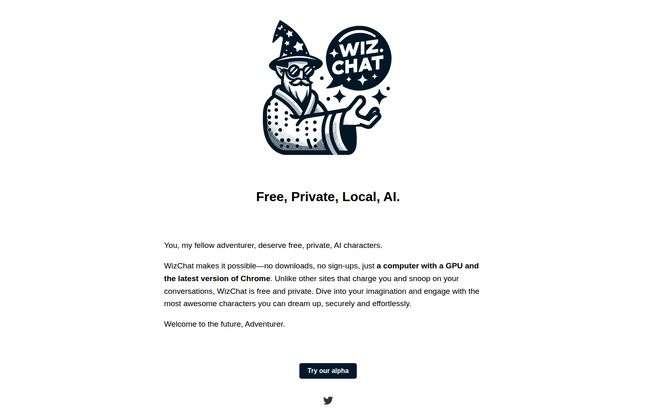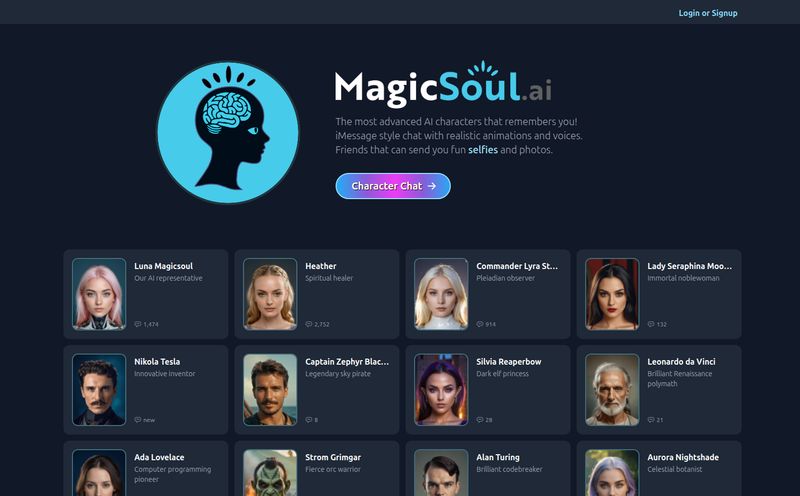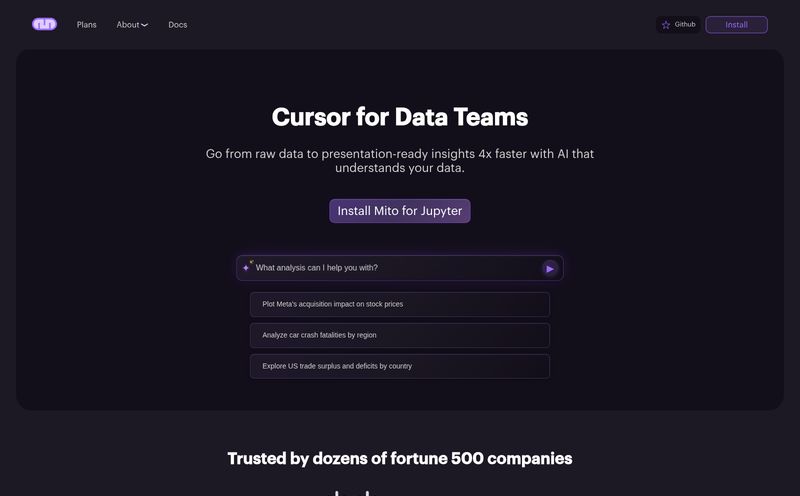My Slack workspace is both my command center and my digital nightmare. It’s where projects live and die, where the best ideas are born, and where I get pelted with a thousand notifications before my first coffee is even finished. We’re all constantly on the hunt for that one tool that will actually make things better, not just add more noise. For the last year, AI has been that promised land.
We’ve seen a tidal wave of AI-powered tools, all promising to revolutionize our workflow. And many of them are pretty great! But they almost always come with two nagging questions: How much is this going to cost me? And, uh, who's reading my prompts? When you're brainstorming a top-secret project for a client, the last thing you want is for your brilliant (and confidential) ideas to become training data for some megacorp's next model. It’s a legitimate concern.
So when I stumbled upon Wizchat, its tagline hit me like a ton of bricks: Free, Private, Local, AI.
Okay, you have my attention. That’s a bold claim in today's AI gold rush. Is it just marketing fluff, or is there some real magic behind this wizard-branded tool? I decided to pull on my robe and wizard hat and find out.
What Exactly Is This Wizchat Wizardry?
First off, Wizchat isn't just one thing. It's kind of a two-for-one special, which I wasn't expecting. On one hand, it’s a productivity bot that brings the power of GPT-3 directly into your Slack workspace. On the other hand, it's a completely separate platform for chatting with AI characters, but with a fascinating twist—it all runs locally on your own machine. No clouds, no prying eyes.
The whole vibe is a bit nerdy, in a good way. They call their users "Adventurers," and the logo is a cool little pixel-art wizard. It feels less like a sterile corporate tool and more like something built by enthusiasts, for enthusiasts. I can get behind that.
Putting the “Wiz” in Your Workspace: The Slack Integration
Let's start with the feature most teams will probably gravitate towards first: the Slack bot. The concept is beautifully simple, which is a massive plus in my book. There’s no complicated setup or dashboard to learn. You just invite the @Wizchat bot to a channel, and… that's pretty much it.
From there, you just mention @Wizchat and type your request. I can already see the use cases flashing before my eyes:
- “@Wizchat summarize this chaotic thread from the last 2 hours.”
- “@Wizchat draft a polite follow-up email to a client who hasn't paid their invoice.”
- “@Wizchat give me 10 blog title ideas about CPC arbitrage.”
- “@Wizchat what's wrong with this python script? [paste code]”
Having this kind of power right inside the place where work actually happens is a big deal. It cuts down on context switching—no more tabbing over to a separate AI chat window, copying, and pasting. It’s all in the flow. But, and this is a question for the real tech heads, the documentation is a little light on specifics. It says it uses GPT-3, but which version? Is it the speedy 3.5-Turbo? Or an older, more powerful model like Davinci? This detail matters for performance and cost on their end, but for now, it works and it’s fast enough.
Your Own Private Holodeck: The AI Character Chat
This is where Wizchat gets really interesting and, frankly, carves out its own unique space. Separate from the Slack bot is a feature that lets you chat with AI characters. Now, I know what you’re thinking. “Isn’t that just Character.ai?” Well, yes and no. The key difference is in those three magic words I mentioned earlier: Free, Private, and Local.
Instead of your conversations running on a company’s servers, Wizchat’s character AI runs entirely within your Chrome browser, using your computer's own GPU. Think about that. Your chats are never sent over the internet. No one can read them, analyze them, or use them for training data. It's your own little sandbox for imagination, completely cordoned off from the outside world. For writers, game masters, or just creative folks who want to brainstorm without a filter or a censor looking over their shoulder, this is huge.
Of course, there’s a catch. This magic requires a bit of hardware. Specifically, a computer with a dedicated GPU. Your average work laptop with integrated graphics probably won’t cut it. This feature is aimed squarely at the PC gamers, the video editors, the 3D modelers… the people who already have some graphical horsepower under the hood. It also requires the latest version of Chrome. So it’s not for everyone, but for its target audience, it’s a killer feature.

Visit Wizchat
The platform is clearly in its early stages—they call it an "alpha" right on the homepage. As you poke around, you get that sense. It's not hyper-polished. But it works, and the core promise of local, private AI chat is delivered.
The Big Question: What's the Price?
Okay, here’s the part that always gets me. How is this free? My inner CPC analyst is screaming, “API calls aren’t free!”
Right now, it seems to be completely free to use. The character chat model makes sense—since it uses your own computer's resources, it doesn’t cost them a dime to run. That's a sustainable and genuinely free model. The Slack bot, however, must be making API calls to OpenAI or a similar service, and that has a server cost.
My educated guess? The free Slack access is likely a way to build a user base while the tool is in alpha. I wouldn't be surprised to see a fair freemium model introduced down the line, maybe with a certain number of free queries per month and a paid plan for power users or larger teams. For now, though, you can't beat the price of admission.
Who Is Wizchat Actually For?
After playing around with it, I have a pretty clear picture of the ideal Wizchat "Adventurer." This probably isn’t the tool your massive, Fortune 500 company is going to deploy overnight. It’s too new, too… well, wizardy.
It's perfect for small, agile teams. Startups, dev groups, marketing pods, and creative agencies who want to get their feet wet with AI in their workflow without going through a procurement process. It's for the curious and the early adopters.
The character chat side is for a more niche but passionate crowd: writers, role-players, developers testing dialogue systems, and anyone who values privacy above all else in their creative AI explorations. If you have a gaming PC, you're basically the prime candidate.
Warts and All: My Honest Take
So, what's the final verdict? I'm genuinely impressed. The biggest pro is the sheer simplicity and the zero-cost barrier to entry. You can have a GPT-powered assistant in your team’s most-used app in about 30 seconds. That’s awesome. And the privacy-first approach of the local character chat is a massive differentiator in a crowded market.
On the flip side, the GPU requirement for the character chat will be a hurdle for many. And the lack of deep technical documentation on the Slack bot's backend might give more data-sensitive teams pause. Its still in its early stages, so you have to accept that it's a work-in-progress, not a finished, enterprise-grade product.
Final Thoughts: Is Wizchat Worth the Invite?
Absolutely. Yes. For what it is right now—a free, easy-to-use alpha tool—it’s a no-brainer to try out. It solves a real problem in a simple way, and the local AI chat is a bold and welcome move towards a more private, user-controlled AI future.
Wizchat feels like a throwback to a more exciting time on the internet, a time of experimentation and fun, before everything got locked down behind a paywall. If you’re a curious team or a creative individual, I’d say invite this wizard to your party. You might be surprised at the magic it can conjure.
Frequently Asked Questions about Wizchat
- Is Wizchat really free?
- As of now, yes. Both the Slack integration and the local AI character chat are free to use during their alpha phase. The character chat is designed to remain free as it uses your own computer's hardware.
- Do I need a powerful computer to use Wizchat?
- For the Slack bot, no. Any computer that can run Slack is fine. For the private AI Character Chat feature, yes. You'll need a computer with a dedicated GPU (common in gaming PCs) and the latest version of the Google Chrome browser.
- How is Wizchat's character chat private?
- It achieves privacy by running the AI model directly on your computer inside your web browser. Your conversations are never sent to Wizchat's servers or any third party, ensuring they remain completely local and private.
- How do I get started with Wizchat in Slack?
- It's very simple. You just need to find Wizchat in the Slack App Directory and invite the `@Wizchat` bot to any of your desired channels. Once it's in the channel, you can start giving it commands by mentioning it.
- What's the difference between Wizchat and ChatGPT?
- ChatGPT is a standalone web application. Wizchat, on the other hand, integrates a similar GPT-powered AI directly into your Slack workspace for team productivity. It also offers the separate, private, locally-run AI character chat, which is a key difference in its approach to privacy and functionality.
Reference and Sources
- Wizchat Official Website: https://www.wizchat.ai/
- Wizchat on Twitter/X: https://twitter.com/wizchat_ai
- A helpful read on the trend of Local LLMs from Hugging Face: Run LLMs on your local Mac



